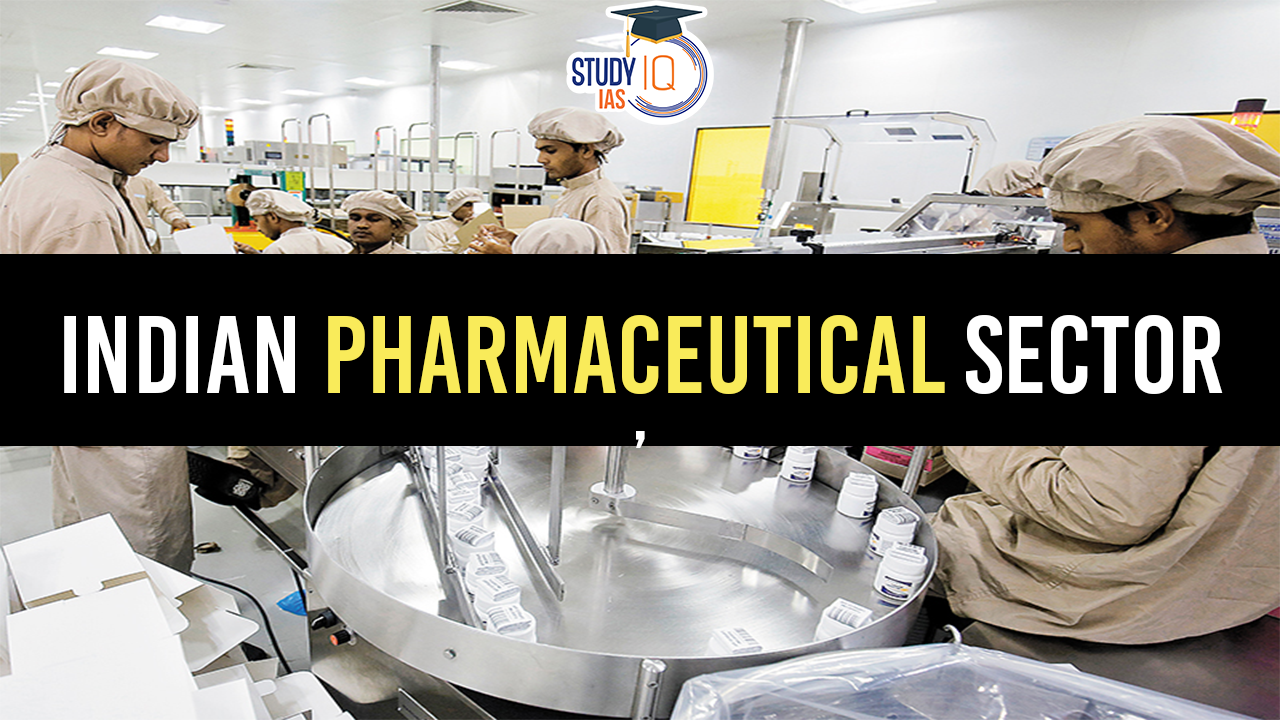Table of Contents
Context: The Indian pharmaceutical industry is expected to reach the $130 billion mark by 2030.
We’re now on WhatsApp. Click to Join
Indian Pharmaceutical Sector: An Overview
Historical Evolution
The Indian pharmaceutical industry has undergone a remarkable transformation over the past century, evolving from a fledgling sector reliant on imports to a global leader in generic drug production. Today, India is known as the “pharmacy of the world,” supplying affordable medicines to millions of patients around the globe. This evolution can be broadly divided into four distinct phases:
Early Beginnings (1900s – 1947):
- This period witnessed the establishment of the first Indian pharmaceutical companies, such as Bengal Chemicals & Pharmaceuticals (1893) and Alembic Pharmaceuticals (1907).
- Initially, the focus was on simple formulations and basic chemicals.
- Production was limited, and the industry relied heavily on imported drugs and technology.
Post-Independence Growth (1947 – 1970):
- With independence, the Indian government adopted policies to promote domestic pharmaceutical production and reduce reliance on imports.
- Policies like the Drug Price Control Order (DPCO) and the Industrial Development and Regulation Act (IDRA) provided incentives for the industry’s growth.
- This period saw the emergence of several Indian pharmaceutical companies that would later become global players, such as Cipla, Sun Pharma, and Dr. Reddy’s Laboratories.
Patent Regime Shift and Rise of Generics (1970 – 1995):
- The Indian pharmaceutical industry’s journey towards global prominence began with the Indian Patents Act of 1970 and the Drug Policy of 1978, which paved the way for Indian companies to establish themselves in international markets.
- By the 1980s, India had shifted from being a major importer of medicine to a leading exporter.
- The 1984 Hatch-Waxman Act in the U.S. further boosted the production of generic medicines, benefiting Indian drug makers.
- The economic reforms of 1991 were a significant milestone, removing licensing restrictions and propelling the industry onto the global stage
Globalization and Innovation (1995 – Present):
- With the liberalisation of the Indian economy in the 1990s, the pharmaceutical industry witnessed increased foreign investment and technological collaborations.
- Indian companies started focusing on research and development (R&D) to develop innovative drugs and novel drug delivery systems.
- The industry also expanded its global presence through acquisitions and partnerships with multinational companies.
Global Positioning
- Global Influence and Pandemic Response: Ranking 3rd globally in volume and 14th in value, the Indian pharmaceutical industry demonstrated its strength during the COVID-19 pandemic, ensuring a steady supply of medicines and vaccines.
- It played a crucial role in vaccinating 2.2 billion Indians and provided over 290 million vaccine doses to more than 100 countries through the ‘Vaccine Maitri’ initiative.
- The industry’s efforts in developing medicines, testing kits, and treatments for COVID-19 highlighted its flexibility and potential, earning it the moniker “Pharmacy of The World”.
- Contribution to Global Health: India is the world’s leading exporter of generic medicines, meeting 20% of global demand, and produces more than half of the world’s vaccines.
- It is a major supplier of vaccines for diseases like DPT, BCG, and Measles and plays a vital role in providing antiretroviral drugs globally.
- The industry has significantly contributed to the reduction of disease burden in India and was instrumental in making the country polio-free in 2014.
Policy Framework
Access to Essential Medicines
- Drug Price Control Order (DPCO): This key regulatory mechanism aims to ensure the availability of essential medicines at affordable prices by fixing ceiling prices.
- National List of Essential Medicines (NLEM): This list defines essential medicines for which the government can control prices and ensure their availability.
- Jan Aushadhi Scheme: This initiative promotes the availability of generic medicines at affordable prices through dedicated Jan Aushadhi stores across the country.
- National Pharmaceutical Policy (2023): Aims to provide a comprehensive framework addressing challenges in the sector. It focuses on global pharmaceutical leadership, self-reliance, health equity, regulatory efficiency, and investment attraction.
- To empower every citizen of India with equitable access to high-quality healthcare through an industry.
Promoting Innovation and R&D
- Patent Act, 1970: This law recognizes process patents but not product patents for pharmaceuticals, encouraging generic drug development.
- Pharmaceutical Research and Development (R&D) Policy, 2017: This policy aims to incentivize pharmaceutical companies to invest in R&D by providing tax benefits and other financial support.
- Biotechnology Industry Research Assistance Council (BIRAC): This government agency provides funding and support for research and development in the biotechnology and pharmaceutical sectors.
- Research and Innovation in Pharma MedTech Sector (PRIP): Launched in 2023 with an outlay of INR 5000 Cr, it aims to transform the sector from cost-based to innovation-based growth, promoting industry-academia R&D linkages.
- Human Resource Development in the Medical Device Sector (2023): Focuses on bridging the industry-academia gap, aiming to develop a skilled workforce and R&D ecosystem in the medical device sector.
Regulatory Framework for Quality and Safety
- Drugs and Cosmetics Act, 1940: This primary legislation governs the import, manufacture, and sale of drugs in India, ensuring their quality and safety.
- Central Drugs Standard Control Organization (CDSCO): This regulatory body is responsible for approving new drugs, conducting inspections, and ensuring compliance with quality standards.
- Good Manufacturing Practices (GMP) and Good Clinical Practices (GCP) guidelines: These guidelines lay down the standards for manufacturing and clinical research, ensuring the quality and safety of drugs.
Trade and Investment
- Liberalised Foreign Direct Investment (FDI) Limit: Allows up to 100% FDI for Greenfield investments and up to 74% for Brownfield, attracting significant FDI equity inflow.
- Scheme for Strengthening of Pharmaceuticals Industry (2022): With an outlay of INR 500 Cr, this scheme aims to strengthen pharmaceutical clusters and facilitate MSMEs to meet regulatory standards.
- Scheme for Promotion of Bulk Drug Parks (2020): Provides financial assistance for domestic manufacturing of Key Starting Materials (KSMs), Drug Intermediates, and APIs in selected drug parks.
- Pharmaceuticals Export Promotion Council (Pharmexcil): This government agency promotes the export of Indian pharmaceuticals and helps companies navigate international regulations.
Challenges Associated
- Quality Control Failures: Incidents of contaminated medicines and substandard drugs have raised significant concerns about product safety.
- Example: In 2022, the US FDA issued a warning letter to Sun Pharmaceutical Industries for manufacturing practices violations at its Halol facility in Gujarat, India. This included concerns over the company’s failure to ensure the sterility of its injectable products.
- Intellectual Property Rights (IPR): There have been cases alleging violations of intellectual property rights laws.
- Example: Glenmark Pharmaceuticals paid USD 87.5 million to three plaintiff groups to settle multiple antitrust and consumer protection lawsuits in the US related to a generic drug.
- Pricing and Affordability: The pharmaceutical industry faces challenges in striking a balance between providing affordable medicines for those in need and maintaining company profitability.
- Example: Controversy surrounding the high cost of a new cancer drug, making it inaccessible to a large section of the population in India.
- Healthcare Infrastructure and Access: There are significant issues regarding inadequate healthcare infrastructure, uneven distribution of healthcare facilities, and low insurance coverage.
- Example: The second wave of the COVID-19 pandemic in India during 2021 highlighted severe shortages in healthcare infrastructure, including a critical lack of oxygen supplies and hospital beds, particularly in rural areas.
- Global Reputation: The challenge lies in maintaining a strong global reputation as a dependable supplier of high-quality pharmaceutical products.
- Example: In early 2023, a batch of generic drugs produced by an Indian pharmaceutical company was recalled in the European market due to concerns over impurities found in the medications, which affected the company’s international reputation
- Regulatory Framework: India’s pharmaceutical sector is regulated by 36 different drug regulatory bodies, leading to confusion and ineffective enforcement of regulations.
- Example: In 2022, Indian drug regulators faced criticism for the fast-tracked approval of a domestically developed COVID-19 vaccine without sufficient phase 3 trial data, raising questions about the regulatory decision-making process.
- Transparency and Credibility: There is a notable lack of public disclosure in drug application reviews, affecting the sector’s transparency and credibility.
- Example: Indian pharmaceutical companies, including Bharat Biotech, faced scrutiny in 2022 for not sharing detailed phase 3 clinical trial data of their COVID-19 vaccine with the public, which led to concerns about transparency.
- Environmental Sustainability: Reports in 2022 highlighted ongoing environmental concerns about pharmaceutical pollution in the water bodies around Hyderabad, a major hub for drug manufacturing in India, raising issues about the sustainability practices of the pharmaceutical industry.
Way Forward
- Amendments to Legislation: The Drugs and Cosmetics Act of 1940 requires updating to reflect modern standards and practices.
- Centralised Database Benefits: Establishing a centralised drug database can improve surveillance and ensure effective regulation across all pharmaceutical manufacturers in India.
- Consolidating Regulatory Bodies: Merging the 36 regional drug regulators into a single entity could minimise regulatory capture and influence networks.
- Uniform Quality Standards: Implementing common quality standards across all states is crucial to guarantee consistent product quality.
- Promotion of Certification: Encouraging pharmaceutical manufacturing units to achieve the WHO’s Good Manufacturing Practice certification can raise the overall quality standards of the industry.
- Collaborative Regulatory Enhancement: The regulator and the pharmaceutical industry need to work together to improve India’s drug regulatory regime, ensuring it is transparent, credible, and in line with international standards.
- Public Disclosure: Revealing drug application reviews and inspection records, along with violation history, is vital for ensuring accountability.
- Positive Regulatory Actions: The Drugs Controller General of India’s (DGCI) revocation of manufacturing licences for 18 pharma companies is a step in the right direction, but more thorough measures are needed to tackle the fundamental causes of quality issues.
- Sustainable Practices: Focusing on sustainable manufacturing practices, including the adoption of green chemistry, waste reduction, and energy efficiency, is essential for the sector’s environmental sustainability and can also help reduce costs.
- Branding and Consumer Attraction: Adopting eco-friendly practices can enhance the brand image of pharmaceutical companies and appeal to environmentally conscious consumers.


 List of Military Exercises of India 2024...
List of Military Exercises of India 2024...
 India to Host First Global Conference on...
India to Host First Global Conference on...
 How Terror Networks Abuse Digital Tools
How Terror Networks Abuse Digital Tools





















